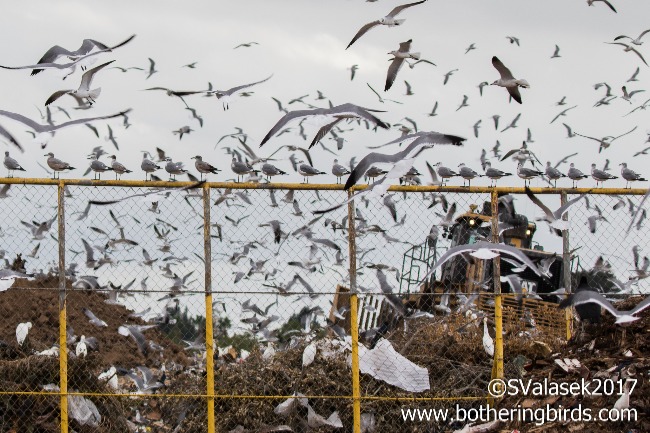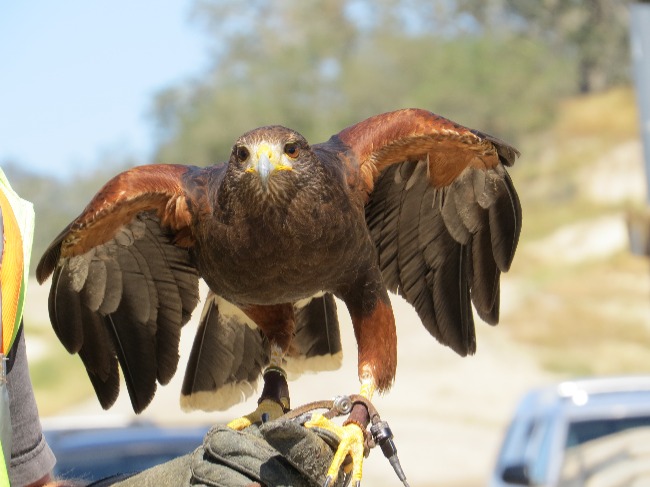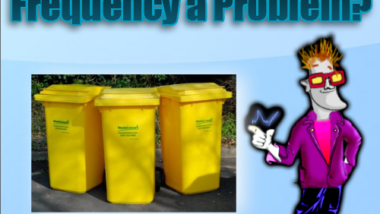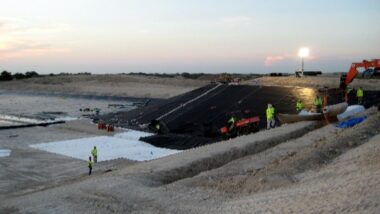Bird control at landfill sites is an important aspect of landfill management. If not controlled, birds become frequent visitors to landfill sites. Landfill birds can be raucous, ravenous mess-makers that long overstay their welcome. The ever-rising amount of food waste in the landfills of many affluent countries can result in a bird population boom. This can create issues both within, and outside, landfill boundaries for many waste sites.
Problems with Landfill Birds

When birds feed at a landfill, they will quickly become immune to traditional methods like loud noises and flashing lights. If the birds nest on or near the landfills, simply chasing them raise issues during seasons when the young hold protection status.
The most important lesson for bird control which young landfill operators soon learn, is that you can only work with nature, not against it.
Some bird control projects have been said to benefit from a extensive ecological assessment, looking into the main locations and habits of local bird populations, before doing anything else.
Birds feeding on landfill sites cause problems in terms of:
- nuisance to neighbours
- flight safety
- a threat to public health due to hygiene risks which arise when birds land in gardens, and overnight on water supply reservoirs causing water contamination. Birds and their fecal matter can carry more than 60 transmissible diseases. Some of these are known to be fatal to humans (e. g. avian flu). Landfill workers are inevitably exposed to such, creating a workplace hazard
- a general landfill site operational hazard which occurs if the noise of birds distracts site staff while performing duties on the landfill
- if birds nest on the landfill, attacks on site operatives with minor injury has occurred
- birds can even drop items they are carrying denting cars, even on occasions causing direct or indirect injury
- corrosion can occur from accumulations of bird droppings. It can damage equipment and cause significant deterioration of exposed components.
What Can Landfill Operators Do as Part of their Normal Working?
Landfill operators can reduce the problem by making numerous site operational changes, such as:
- reducing surface garbage on the active waste tipping cell at the end of each day, and whenever possible during the working day
- covering waste at day's end, with temporary cover (soil) material (a slurry-based alternative daily cover material may be available that sprays the landfill's open working face with it) and
- diverting food from the landfill
- placing suspended netting systems completely enclosing all active tipping areas.

A number of control measures exist to deter problem species, however, research into their effectiveness across sites and for multiple species has been limited.
The use of:
- distress calls,
- falconry, and
- combinations of lethal and non-lethal use of ammunition were noted as the most effective techniques for initially deterring birds from many sites in the past.
However, when habituation is considered, there is a clear difference between techniques such as falconry, which have a lethal aspect and may act to reinforce the deterrence, and the use of techniques such as distress calls, which do not.
Common species which build-up to pest levels in Europe can be:
- gulls,
- starlings,
- crows, and
- ravens.
Above all it is the gulls that predominate in the UK.
In some countries including parts of the US eagles may be a problem. US Eagles were protected under the federal Bald and Golden Eagle Protection Act, until there was a population boom. That officially took them off the federal list of threatened and endangered species in 2007. But, they remain protected under the federal Bald and Golden Eagle Protection Act from being harmed, trapped or disturbed in any way.
Whether it's an aggressive eagle population or another species that occupies a site, the first step for operators looking to ward off any bird population nuisance is knowing what you are dealing with.
Whether dealing with eagles, smaller birds or a more varied flock, the primary bird control technique is always:
- identify their main motive for visiting the landfill and
- remove their access to it.
This is especially important to do before the birds nest in the area, if possible, since nesting equates to a more permanent presence in the vicinity.
Scavenging birds such as gulls may range over a wide geographic area to search for food. They can travel upwards of 30 miles each day from feeding to roosting sites. Commuting regularly, they also fly between breeding colonies and landfills to feed their young during the breeding season.
Landfill Birds and Aircraft Flight Safety
There is a potential for tragedy when birds hit planes.
Birds such as those, which fly in groups or lines, and cross the approach and departure paths of aircraft can thus pose a serious risk to aircraft flight safety.
If a landfill site is situated directly under the approach to a runway, aircraft may also be at risk from soaring birds which may rise in good weather on thermals above a site.
In a number of countries, including the UK, safeguarding legislation has been developed to assist an airfield to protect flight safety in its surrounding airspace.
Bird Netting Exclosures
The UK Civil Aviation Authority (CAA) requires the provision of on bird netting exclosures. These are required for any landfill site within 8 miles of an airfield.
Bird netting exclosures cover the whole of the working area of the landfill and, when properly operated can be very effective.
By preventing access to edible waste at a landfill, birds are no longer attracted and bird numbers drop to close to normal population densities.
Solutions to Bird Control at Landfill Sites
Many bird control solutions may work initially, but birds are adaptable and intelligent enough to become acclimated to techniques if any one process is over-used.
Netting systems don't suffer from bird adaption to them. However, they are expensive and do need the netting at the vehicle entry points to be maintained and opened and closed frequently. It's essential to prevent bird entry.
Traditional Methods
Traditional methods include:
- flying a bird of prey over the landfill regularly,
- visual decoys,
- sonic and ultrasonic systems.
- Plus, pyrotechnics (e.g. flare pistols) and
- gas cannons.

Devices are also available that;
- emit an irritating scent to flying birds, and that
- imitate prowling owls.
- There is even a menacing 3D balloon with holographic eyes, which its manufacturer claims repels both pest birds and small animals.
In some countries chemical methods, and bird kills at a permitted rate of bird culling may be used (not permitted in the UK).
But, none are as frequently recommended as flying birds of prey. Falcons, and hawks are real-life prey which all birds never fail to give a very wide birth.
Bird Control by Broadcasting Distress Calls
Electronic bird control units programmed to broadcast the right species distress calls can, according to some specialist equipment suppliers permanently repel pest birds from a landfill or dump.
These are promoted on the basis that nuisance birds can be got away from a landfill or dump without chemicals, nets, or poisons.
Electronic Bird Control Systems
In modern electronic bird control systems, built in microprocessors in the electronic bird control units, continually randomise the order the sounds played. They may also alter the relative pitch of each bird sound to give the impression that many birds are in distress in the protected area.
Experts in this technology say that the random nature of their technology prevents pest birds from becoming habituated. This avoids the birds becoming familiar with the synthetic distress sounds. And, this the sellers say, will keep nuisance birds away from dumps and landfills year-round. It is also a humane way to repel nuisance pests while having a minimal adverse effect on the environment.
Controlling Landfill Birds by Laser
A new product to be offered recently on the market for landfill bird control is a laser bird repeller.
A laser tower is erected which is itself a visual deterrent. Once the tower is completed a laser is installed which continuously scans the landfill area.
To the human eye the laser beam appears as a green dot. But, the inventor claims that birds see this as a 3D form. A from which they perceive to be a predator approaching them and it scares them off. Powered by solar panels, these system can function night and day to protect landfill sites.
As the lasers are environmentally friendly, have higher efficiency and lower overall costs, this tool could be a very promising solution for landfills.
Concluding Our Article on Bird Control at Landfill Sites
Landfill sites and large flocks of birds don't mix and measures have to be taken sooner or later to control landfill birds humanly. Alfred Hitchcock showed the world over 50 years ago just how scary swarms of birds can be. Bird populations around some landfills can easily exceed 10,000 without bird controls in place. There is no question that landfill managers need to know find and implement effective methods to control pest bird populations.
Landfill sites close to an airfield
Also, important is not to overlook the likely bird attraction of each landfill site close to an airfield. Each landfill needs to be individually evaluated for flight risk prior to determining a regime of bird control techniques.
Birds which have the opportunity to gain access to feed at a landfill site for even short periods of time will continue to attract large numbers of birds.
Where daily flight lines from bird roosting / and breeding sites to the feeding area occur, ecological studies should be done. These must ensure that the bird strike hazard to any nearby airports is controlled and the risk is severely limited.
Combining Techniques for Long-term Success
It is apparent from the results that it is unlikely that any one technique will prove to be completely successful at achieving effective bird control at landfill sites.
A variety of techniques therefore need to be integrated into a bird control plan using several techniques. The plan must be tailored to the specific factors affecting an individual site.
Birds have been shown to habituate to techniques if used too frequently, control may not be practicable in poor weather conditions, whilst material considerations at the landfill site may restrict the use of some systems.
Success Factors
Seasonal factors, geographic location and the presence of existing bird populations in an area all affect the attractiveness of a site to scavenging birds and thus the efficacy of control techniques.
Results of research into a large number of bird control trials has been accepted as clearly showing that almost all techniques are affected by one or more adverse factors when used to control birds at landfill sites.
Falconry
One of the best is to seek out and hire a falconry breeder of birds of prey in captivity for enthusiasts who wish to buy young falcons, sparrowhawks and the like. They train them and compete with them in country-sports events in the summer. To provide a service they may seek no more than a retainer fee to visit the landfill, and fly their birds regularly on the landfill.
No Universal Solution
However, individual techniques which have been demonstrated as successful at preventing birds from using one landfill site, may fail at another. Keeping birds of prey is a specialised skill requiring 24 hour dedication, and not something to be undertaken by normal landfill site staff.
Ring the Changes, be Flexible/ Change Things Up
Successful control is thus only likely to be achieved through the integration of a variety of methods specifically targeted to each particular site. And. it is of course also essential that bird control personnel are adequately trained.
Ultimately, it takes money and continual vigilance to effectively control pest bird populations. The common experience of landfill site operators has shown that there is not a magic method. But, what can be said is that birds will inevitably return in large numbers, if defences are not maintained.
Can You Visit a Landfill Site in the UK?
Can You Visit a Landfill Site in the UK? Have you ever wondered if you can visit a landfill site in the UK? Many people think about what happens to their rubbish after it gets taken away. So, why not go and see one? Not an old one, long since covered in soil and made […]
Unfashionable Talk About Landfills
Get ready for unfashionable talk about landfills! Let's talk rubbish—literally. You might not think about landfills much unless the smell drifts your way on a windy day or you're tossing out the garbage. But these dumping grounds are more than just piles of junk; they're a snapshot of our consumer habits and a challenge we need to tackle. Landfill […]
Sustainable Organic Waste Disposal is More Than Just a Diversion
In recent years waste management experts often talk about diverting organic waste from landfills. In this article, we explain why diversion is just the first step in a virtuous circle toward much more sustainable organic waste disposal. Read on to find out why sustainable organic waste disposal is more than just a matter of diversion. […]
How Many Landfills are There?
To ask how many landfills there are is an interesting question, but not a quick one to answer. It may be answered as a question at the national level of “how many landfills in my country” and we will do that for a number of countries in the sections that follow, but first, we will […]








